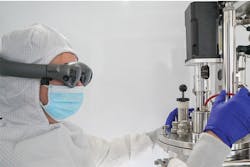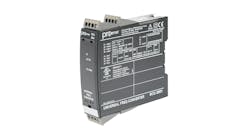Artificial intelligence and augmented reality for the pharmaceutical industry
Manufacturing safe, cost-effective pharmaceuticals or biologics on an industrial scale is a complex process that requires advanced operational precision and sophistication. With the global pharmaceutical market estimated to reach $1170.4 billion by 2021, pharma and biotech industries are pushing for advanced life-saving research and strong production fulfillment. Prescription drug sales are specifically growing at an impressive rate, with research and development (R&D) spending sourced mainly from the manufacturing side. As a result, these industries require new ways to avoid deviations and manufacturing delays while streamlining their processes.
That’s where augmented reality (AR) and artificial intelligence (AI) step in.
Augmented reality overlays data into a user’s physical environment to provide critical text or user tools at the moment it’s needed. AI introduces intuitive guides, machine learning and data capture to streamline processes.
It’s no secret that AR and virtual reality (VR) have come a long way since Pokémon GO, the popular mobile AR game released in 2016. The AR/VR industry is anticipated to hit $94.4 billion by 2023, with AR leading the way. It is proving its worth in manufacturing, playing a significant role in improving maintenance, production, validation processes and training.
AI alone is predicted to grow to $72 billion in 2021 and is appreciated for its ability to improve workflows based on predictive analytics.
A significant number of use cases for AI in manufacturing exist, making this area one of the most invested-in by the global venture capital community. Combined, AR and AI-powered tools improve communication, collaboration and efficiency, which greatly reduces equipment downtime and keeps production schedules on time.
Today’s AR and AI technology can efficiently tackle a broad range of challenges to support all-day workflow solutions that not only empower users, but increase safety and efficiency in manufacturing. We’ve seen over the years how implementing these reliable, cost-effective technologies can overhaul processes on a global scale, greatly advancing an organization.
Whether operators are executing batch records, following standard operating procedures (SOPs), working on complex equipment assembly or conducting safety clearance tests, AR and AI enhances the overall experience. This technology augments workflows, bringing in additional resource material and verification capabilities among many others. AR platforms make the everyday worker on the manufacturing floor an empowered worker thanks to these performance-enhancing tools.
It should come as no surprise that solution platforms built on this technology are being quickly adopted into labs, processing lines and manufacturing suites across the world as a way to increase safety, reliability and overall return on investment (ROI).
Among the many benefits of implementing these technologies in enterprise manufacturing are seamless integration capabilities, a wide variety of use cases and flexible device compatibility. It remains appealing to both small- and large-scale manufacturing. Depending on the use case and facility, users can engage in an enhanced AR experience on a headset, iOS or Android device.
On the manufacturing repair side, this technology is specifically leveraged to help operators follow procedures, identify equipment malfunctions and easily capture critical data. For instance, operators working in a manufacturing suite can use AR to connect with remote experts around the globe. Through AR-driven remote telepresence, operators can utilize "see-what-I-see" functionality to instantly connect with subject matter experts (SMEs). Operators can obtain immediate assistance, identify malfunctions and quickly repair machinery on the manufacturing floor without delay. Not having to delay productions or spend time waiting to fly an expert into a facility is a huge advantage for this industry and others like it. There are also various opportunities to use these telepresence experiences for training documentation as well.
SMEs can use AR tools to draw directly on an operator’s screen, use a laser pointer to hover over areas in an operator’s workspace, or drop an augmented reality pin in the operator’s physical environment. Troubleshooting becomes instantaneous, at the moment a problem occurs.
Operators on the production side of manufacturing can harness AR to access batch records and additional data. SOPs can even be linked to equipment information or data on how a procedure, method or process is performed. There are even opportunities to incorporate real-time performance feedback/correction at the moment a task is completed. These features reduce the potential for error and increase productivity and overall capabilities. In the event that a misstep in procedure occurs, the operator can categorize and log notations or comments accordingly. Those notes can then be used for reference, ensuring audit readiness.
This AR-enhanced content and rich data provides a more in-depth look into process completion. Imagine accessing a video tutorial of how to properly identify and connect hosing within a single-use system, right at the moment you need to perform that task. When you begin to introduce AI data capture tools to manufacturing, you also drastically reduce the amount of time spent on data entry or data correction. This is a huge advantage to an organization.
Another upside to these high-tech solutions in manufacturing is that the technology itself is flexible. It can be supported by a wide variety of devices — from mobile devices or tablets, to headsets, to fully immersive products. Environmental factors and specific use cases will dictate what type of content and device should be used.
The introduction of Apple ARCore and Google ARKit 2 mobile solutions now provides a familiar method for capturing data or accessing workflow tools. In flexible environments, users have the ability to use devices they are likely already familiar with, with the same goal of successful task completion.
For complex environments in which users need to operate with both hands, AR-driven headsets can be used. Headsets have made a significant impact on enterprise manufacturing, allowing operators to receive critical data or instruction while remaining hands-free to perform a task. This is often a critical component to industries such as pharmaceutical R&D and manufacturing.
Due to regulatory protocols and competitive pressures, these industries are starting to undergo significant change. To keep up with market demands, increase performance and optimize delivery chains, a successful organization will recognize the need for smart technology such as that of AR and AI. These tools are invaluable to an organization, effectively pushing it to the industry forefront while empowering users across all facets of the workplace. It won’t be long before all operations are AR-enhanced experiences empowering users across the world.
Angelo Stracquatanio is CEO and co-founder of Apprentice, providing award-winning industrial augmented reality solutions for enterprise industries. As a pioneer of AR and AI for human empowerment, Stracquatanio has positioned Apprentice as a worldwide leader in innovative technology. He imagines a world in which a synergistic relationship generated between man and technology exists so that meaningful research, lifesaving product development and manufacturing are all executed with greater control, safety, productivity, stability and reliability. Stracquatanio previously developed enterprise mobile applications for global Fortune 500 companies. He holds a Bachelor of Science in finance from Seton Hall University and studied computer science at NYU.


